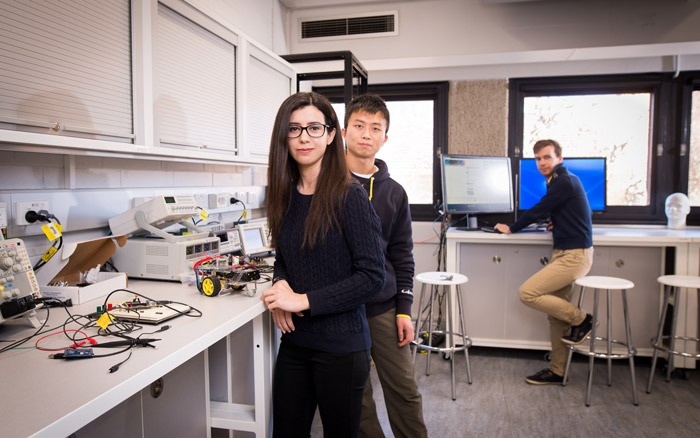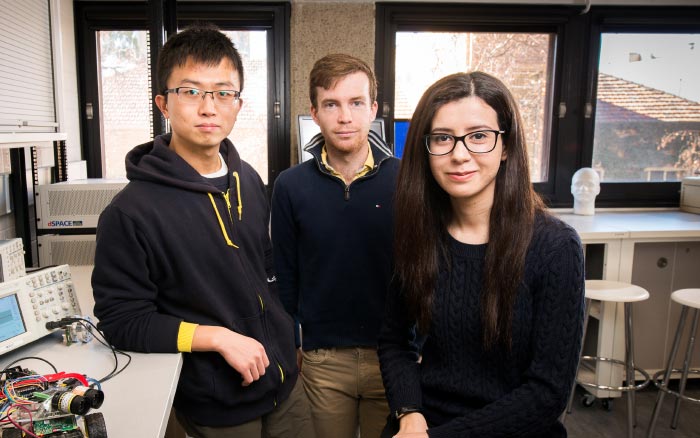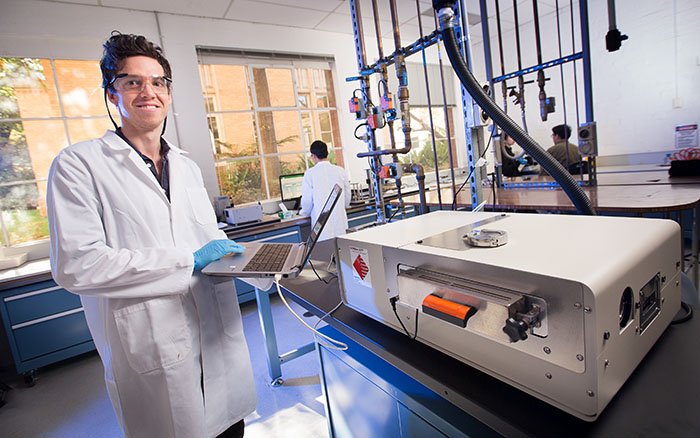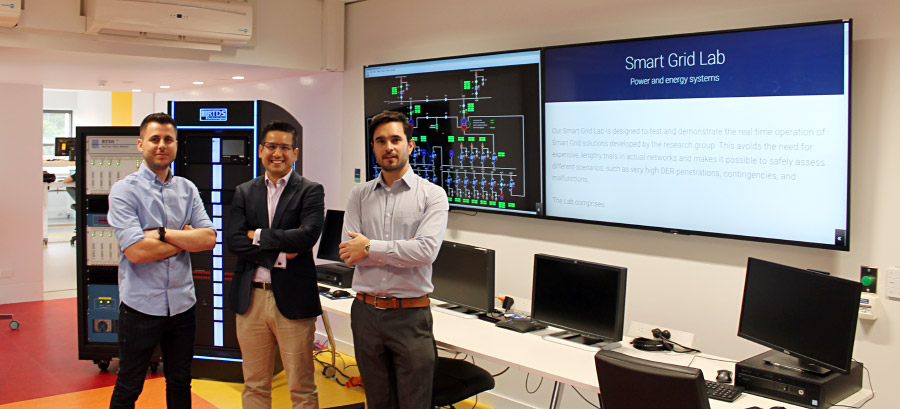Capstone Hall of Fame
A capstone project is the crowning jewel of your Master of Electrical Engineering degree, it is your opportunity to bring the knowledge and skills you gain to fruition on a year-long, complex, engineering project.
To give you a flavour of what your capstone project could entail, this page provide examples of projects completed in the past years. Some projects are posed by our industry partners, some projects are initiated by students, while others are closely connected to the cutting edge research of the department. All capstone projects receive mentoring and supervision from an academic of the department.

Implementation of Knowledge Transfer in Machine Learning
Effectively transferring previously learned knowledge to a new domain is one of the hallmarks of human intelligence (e.g., people good at playing the guitar are more likely to learn ukulele faster). As an analogy in machine learning, transfer learning is a rising technique where we develop a model for a new task through the knowledge learned from a related but different task. Generally, abundant data is needed to train a model for a task but access to that data is not always available. Transfer learning is particularly useful when there is insufficient data for a new problem and there is a big pre-existing data pool that can be transferred to the problem. As a consequence, transfer learning can be vital in certain applications such as digit recognition, text classification, and medical imaging where obtaining large data sets for training models is either costly or impossible.
In this project, you will become familiar with general transfer learning methodologies, and then develop novel and efficient transfer learning algorithms for general machine learning problems, such as image recognition. For example, in training a classifier to predict whether an image contains food, you could use the knowledge it gained during training to recognize drinks. You can use statistical learning methods or construct deep neural networks to achieve effective knowledge transfer.

Learning-based Model Predictive Control for Unmanned Vehicles
This project aims to implement/develop learning-based optimal control algorithms for path planning and following for unmanned surface vehicles (USVs) based on cameras. The learning-based/data-driven techniques are first used to seek a mathematical model for unknown dynamics of the USV based on the collected data from the cameras. The learnt model and the environmental information will be used in the MPC controller design. To demonstrate the algorithms, the students need to convert an AION rover (https://www.aionrobotics.com/r6) into USVs by re-designing, modifying, and prototyping mechanical parts. The students are also expected to develop a simulation platform to test the algorithms before launching them on real robots

MUR Accumulator
The Accumulator team running in semester 2 2021 aims to make a head start on the design and implementation of the 2022 electric race car for the Melbourne University Racing team in collaboration with the mechanical chassis team. The project will aim to improve efficiencies and reliability in the design of a new battery pack whilst allowing for early completion of the 2022 vehicle to extend the testing timeframe. With the aid of the HV team already looking at the feasibility of regenerative braking on a Formula SAE electric race car, the team will aim to reduce the energy capacity and hence pack size whilst utilising energy efficiency measures. They will explore optimisation of battery management and cell balancing, as well as facilitate the introduction of active cooling to ensure safe operation of the vehicle. With the MUR team looking to optimise their performance at the competition, all designs will need to comply with the FSAE-Australasia rules published annually, whilst innovations explored by the team will be encouraged for the progression of the automotive industry.

Development of a Spatially Adaptive Photographic System
Australia Post is an Australian Government owned entity that has 4429 metropolitan retail outlets and 2561 retail outlets in rural and remote areas. In addition to postal services, Australia Post provides passport photo facility in over 1500 outlets. Australia Post has encountered a critical technical problem: the quality of the photos taken varies depending on the illumination conditions residing inside different Australia Post outlets. This gives rise to background and facial shadows which in turn, causes problems for facial recognition technology to verify the identity of people. Moreover, even the most sophisticated flash in cameras cannot solve this problem as their illumination reduces sharply with distance and making the photos look unnatural or uneven. Therefore, this project aims at addressing the problem of facial and background shadow with the design and development of a photographic system, using an intelligent flash array unit integrated with a camera and processing unit to target facial shadow, and an adaptive back-light system to removal background shadow. Students will get access to Australia post outlets for testing the system.

Bluetooth Hearing Device
Attention problems are common in the classroom. Many children have trouble clearly hearing the teacher’s voice above the background classroom noise. Commonly used strategies, including stimulant medication have side effects. An alternative approach is to use a remote microphone assistive listening device (FM radio/hearing aide), which boosts the signal-to-noise ratio for the listener (child). Currently available devices are expensive and can attract a stigma when worn in the classroom.
Students are invited to apply for this collaborative project to create a Bluetooth-based hearing assistance device. The challenge is to create a working protype with a mobile app that syncs a Bluetooth microphone (worn by the teacher) with Bluetooth headphones (worn by the child). Students will be asked to optimise audio latency and syncing.

Link-Level Performance Analysis for 5G mmWave Communications
In this industry project you will work with Telstra to study the performance of very new 5G mmWave communication systems. You will do this by running extensive simulations within the MATLAB 5G Toolbox. There are a number of potential areas of focus included below. You might not know what all of this means yet, but you will soon if you pick this project! 1. Quantify and contrast the mm-wave link level performance with different antenna and channel correlation matrices (also referred to as spatial channel correlation) for TDL channel models based on 3GPP and others in the literature. Develop a framework for generating the correlation matrices within the Matlab 5G toolbox. 2. Identifying techniques to reduce the computation time for link level simulations while maintaining accuracy and consistency in the link performance curves. This is important for the larger scale MIMO systems that are expected to be implemented at mm-wave frequencies once digital antenna processing becomes available. This work would focus on the impact of minimising the number of multi-paths in the 3GPP models on both the link level performance and the simulation time. 3. Modelling channel estimation in the Matlab 5G tool box. The aim of this would be to understand the realistic channel estimation method used in the Matlab 5G tool box compared to other approaches to non-ideal channel estimation.

Demand Analysis & Solar Energy Forecasting Using Real-time Data
As sustainability concerns and climate change become a part of everyday conversation, it is a rewarding time to get involved in improving how solar PV panels can be more efficient and making them a more desirable asset. With this project, the students will have an exciting opportunity to work with real-time data collected from SolShare, the world’s only hardware for sharing rooftop solar to multi-tenanted apartments. SolShare actively monitors demand and solar PV generation, and optimally distributes solar energy from a single rooftop system to multiple units. In this project, the students will work on demand side data and solar energy data. They will learn and use signal processing and machine learning algorithms to identify which house appliances are being used at any time to drive demand response management and forecasting techniques for short-term solar forecasting to improve the energy distribution algorithm. Then, they will develop optimisation algorithms to dynamically share solar energy to minimise export to the grid and maximise customer utilisation. These algorithms will then be tested in a simulation bench set-up to confirm their performance. After successful testing, the algorithms will be potentially used in actual products operating all over Australia, Europe, and the USA.

Real-Time Visualization and Control of DER in Distribution Networks
Australia has one of the largest percentages of houses with PV systems in the world. The uptake of residential battery storage systems is also growing. While these distributed energy resources (DER) bring challenges to the operation of the electricity network, it also brings opportunities. However, distribution companies (who manage the poles and wires) do not have platforms that help visualise, understand, and control all these new interactions between the network and DER. Such platforms are required to ensure the most effective transition to the widespread adoption of DER. In this project, students will develop a detailed model of distribution networks as well as DER (and customers) using the Real-Time Digital Simulator (RTDS) in the Smart Grid Lab to enable real-time monitoring of network and DER parameters at various nodes and to demonstrate their interactions. Furthermore, control strategies will be investigated to understand the extent to which DER could be controlled to avoid negative effects on the network. Using a SCADA platform, a graphical interface is to be developed to mimic a control centre and visualise data from the grid (power flows, voltages, DER settings, etc.)